How is spring breaking in your neck of the woods?
This has been the winter from h … well, it’s hot there, and frozen here, so that doesn’t make sense. Let’s just say that when I ask Chicago natives how the winter of 2018-2019 compares to all the other winters they’ve lived through, they say it’s one of the worst, if not THE worst. Snow by Thanksgiving, temps of -27F, 30-plus days in a row with some sort of precipitation, the record lowest high temperature (12F) recorded in March since 1943 …
But enough with my problems! It’s gotta be spring somewhere, which is why I’d like you to weigh in with how the season is starting. If you are a grower or retailer in the Southeast, Deep South, Southwest or West and are shipping and selling annuals and perennials, tell us how it’s going. What’s the season look like so far? Are consumers positive and energetic? Or are they tentative, cheap or scarce? Let me know via a quick email to beytes@growertalks.com. Include your state or province, please.
And if you’d like to give last weekend a 1 to 10 score, feel free, as this informal question is a forerunner to my annual Weekend Sales Summary. That will kick off with the first weekend in April, so be prepared to start shooting me your weekly scores.

Hausermann’s annual open house
Speaking of weekends, Orchids by Hausermann’s in the Chicago suburb of Villa Park held its 54th annual (or was it 55th?—they’ve lost track) open house over the past two weekends. I try to drop in every year for both the beauty of the orchids and the chance to see hundreds of consumers dropping big bucks on cartloads of tropicals. This year, they were dropping more than in recent memory, Gene Hausermann told me after the dust had settled.

“It was the best one we’ve had in years, I would say. Last year was good, this year was better. Sales were probably up 10% or maybe even 15%,” he estimates.
Another gauge is the parking lot. The Hausermann’s don’t take a head count, but the parking lot was fuller than last year. Gene told me you’d have to go back “many, many years, to when orchid prices were higher,” to find a better open house.
To what does he attribute the success?
“Well, it could be cabin fever,” he says. “[It’s been a] long, cold winter and people want to get out.” But he thinks it’s more than that. Even during regular weekday hours, they’ve been getting more customers. “Even with the really cold winter, we’ve still had better sales than the year before.”
Curious if that was due to the indoor plant trend, I asked if he’d noticed a change in the demographics of the customers coming through the doors.
“Yeah, we’ve had some younger ones,” he said … “and also some new old people,” he added with a laugh. “It’s an older crowd that comes here, but you do see young people, too.”
As for what’s selling, Gene says that over the past two or three years they’ve seen an uptick in interest in the species types of orchids.
“People are all the time coming in with their phone and asking, ‘Have you got this one?’ It’s all unusual stuff. There seems to be a real interest in that kind of thing, and so we’re kind of focusing on that more than we used to.”
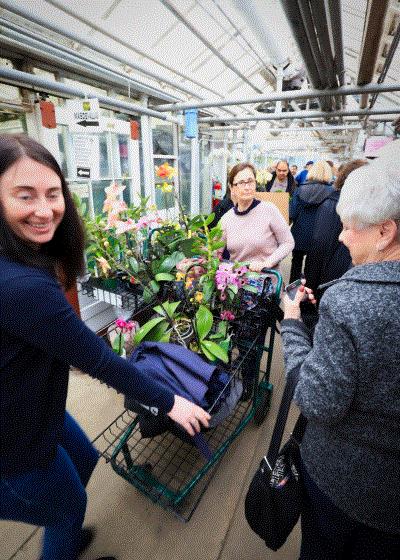
Leaving with a cart load.
By the way, Hausermann’s is celebrating 99 years in business … and some of their greenhouses may date back to about then! Chicago’s extremely cold, windy and snowy winter must have been tough on the old bones of the facility, but Gene said they held up well, considering. Thankfully, last fall they replaced a boiler burner that dated back to the 1950s because parts were hard to get in an emergency. The efficient new one practically heated the entire facility itself.
One tip Gene shared for holding heat in an old, leaky greenhouse: Leave some snow on the roof. They purposely didn’t melt it away so it would provide a layer of insulation when the temperature plummeted.

At the Housewares Show
Saturday was orchids, Sunday was the giant International Home & Housewares Show at McCormick Place in Chicago. I attend every year or two to see if and how the kitchen and bath folks are using our product to enhance theirs. Occasionally I even find a new product or two.
This year I found one of the darlings of Instagram, monstera, in five different booths: on platters, plates, placemats, paper napkins and even as the colorful backdrop for a company whose main product is a weird little scraper of those fabric “pills” that form on your sweaters. I asked the women in the booth if they knew what plant they were standing in front of; they didn’t, but they said Jennifer, the marketing manager would, because it was her idea. So I asked Jennifer, why the giant monstera leaf? “Because it’s beautiful!” was her reply. Check them out:
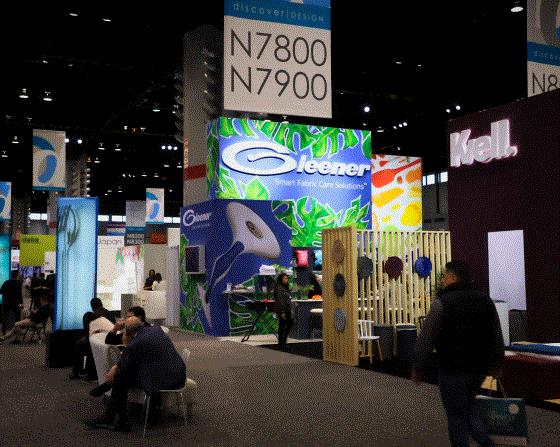

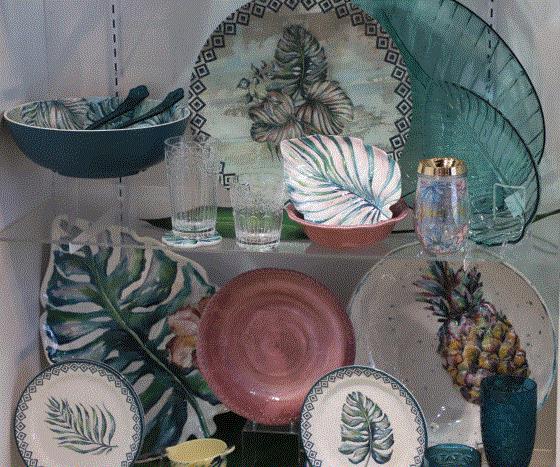
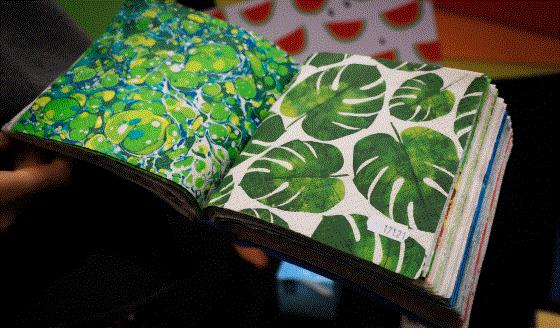
We didn’t see as much cacti- and succulent-themed stuff, but we saw a bit (including plastic plants). These fun items are from Boston Warehouse Trading (I love the cute salt and pepper set on the top shelf!):

Asking around about general trends, I was told that tropicals, along with cacti and succulent patterns, are indeed hot. Florals and seascapes remain popular. Blue and white is a hot combination, which explains these cool blue monstera dishes:

Numerous companies created pretty tablescapes, and I noted that Libbey Glass made nice use of our materials for this fresh spring dinner setup:
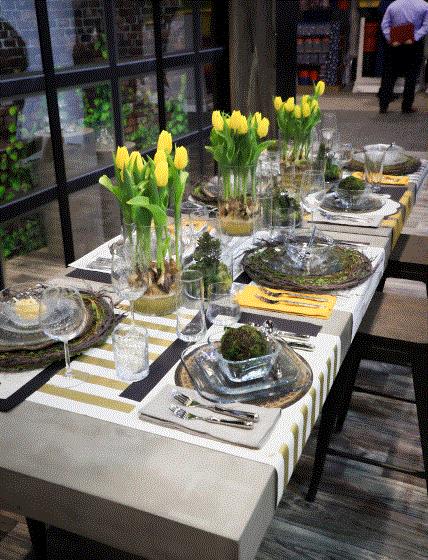
I assumed the tulips were silk, but then discovered no, they’re real, from Bloomaker of Waynesboro, Virginia. Bloomaker sources their glass vases from Libbey. These were picked up at a local Costco.

How to tell your monstera from your selloum
When showing my horticulturist/tropical plant geek wife my photos, she taught me the difference between a Monstera deliciousa leaf and a Philodendron selloum leaf: the margin of a monstera has a nice neat outline, while a selloum is more freeform. Aha!
Minimum wage … from an employee’s perspective
An aspect of a rising minimum wage that’s rarely discussed is what you do for employees who are already making more than the minimum. Should they get an extra dollar for every dollar the minimum goes up? What if you put your extra payroll into keeping up with the minimum wage and ignore your more senior staff?
A nursery employee from New York weighed in with his (or her; we are keeping this incognito) experience with the topic:
Here in New York, minimum wage is already up to $15 in New York City, with small employers (under 20 employees) at $13.50. Where I live and work on Long Island, where the cost of living is almost as high as in the five boroughs, our minimum wage has been steadily increasing since 2014 and we are currently at $12, up from $8.75 in 2014. By 2021 we are supposed to be at $15.
As a non-minimum wage horticulturist/salesperson/native plant and pest ID specialist) in a wholesale nursery, and after discussing it with the rest of the staff, I can attest to the fact that, while minimum wage has been increasing steadily, the non-minimum wages within my company have not been climbing nearly as quickly as the minimum. The best “raises” come, as usual, when we move to other companies.
When I went in for my review last month, I was told that this year they couldn’t afford large raises because “costs were rising.” I assume we were told this because more than half the seasonal staff is at minimum wage.
I’m a year-round employee involved in horticulture, office procedures and in sales. Our staff knows how much over the previous years’ gross and net we do. The last two to three years have been getting progressively better as we come out of the recession. We’ve seen substantial increases in gross sales. Granted, greenhouses aren’t cheap, and electric carts and product cost money, but it appears that the non-minimum staff’s salary is partly where they are cutting costs.
Eventually, as staff leaves because the salary isn’t high enough and other companies are offering more, perhaps we’ll see an increase in regular salaries here at the nursery. Part of my job is "trending," so I keep an eye on industry standards. For now, most of the companies in the industry on Long Island don't seem to be offering significantly higher salaries than before.
If I think about it, it irritates me because it means in comparison to those paid minimum wage, the pay of someone who has a skillset has been dropped significantly, percentage-wise. I understand why the powers that be think it is necessary. But when I was growing up, minimum was what we kids received for working at minimum-skill jobs. Now, here on Long Island at least, our children don’t seem to want those jobs, or else the company hiring would rather have an adult instead of a teen. The jobs are instead being taken by adults, generally with English as a second language and/or little to no skill. Their families cannot be supported on the prior minimum wages. I don’t know whether to be happy that these families can now support themselves without resorting to government incentives and handouts, or angry at the government for creating this particular situation over the last couple of decades.
I work in one of the best nurseries on Long Island, and I really do love my job and don’t want to switch to another nursery, or to the environmental field, so I just try not to think about it. But I am outspoken enough that, when I see the trend shift, I WILL ask for a meeting to discuss my continuing employment ... and well-enough-regarded here to hopefully get my “percentage over minimum” back.
It should be an interesting few years.
You know what this tells me? That you’d better be cognizant of how your valued, higher-wage employees are viewing the whole discussion. Don’t assume they don’t care because they already make $18 or $20 or even $25 an hour. Quite the opposite. Don’t let them feel unappreciated, or worse: slighted in favor of some unskilled newcomer.

Perennial Pitfalls webinar now on on-demand
It was a rip-snorter, with a giant attendance! What? You missed “Perennial Production Pitfalls” featuring Laura Robles of Walters Gardens? Well, thank goodness we recorded it. You can find the whole webinar at our archive location, www.growertalks.com/webinars. Just scroll down below the upcoming events.
Speaking of which, I’ve got two more webinars scheduled, including one this Thursday:
Making the Better Mix: Wood Fiber Research and the Benefits of Adding HydraFiber
Thursday, March 14
As you search for materials to control costs while delivering high-quality plants, you’re hearing endless talk about wood fiber and its use as a suitable alternative to perlite, peat, pine bark and coir. How to make heads or tails of it all and decide if it’s time to transition your media program? Guest experts are Dr. Glenn Fain of Auburn University and Daniel Norden, Senior R&D Manager and Technical Specialist Manager for Profile Products.
What Makes a Growing Container Automation-Friendly?
Thursday, April 18
As the horticultural industry struggles with labor challenges, the subject of greenhouse automation is more relevant than ever. Having the right container—one that fits the requirements and specifications of your equipment—is critical. But what makes a growing container automation friendly? And if you don’t have automated equipment, are there any manual solutions to help minimize labor costs while maximizing efficiency? My guest expert is Chris Soltis, Director of Sales for HC Companies, maker of ITML and Dillen pots, among others.
Get more details and sign up for one or both at www.growertalks.com/webinars.

AmericanHort launches Garden Retail Profitability series
Here’s a solid new resource to help you figure out how much money you’re making (or losing) at your garden center. AmericanHort is offering a four-part video series in conjunction with Steve Bailey Consulting and The Garden Center Group on Garden Retail Profitability. You’ll learn:
- Review of the income statement, or P&L
- Pricing and margin
- Inventory management and inventory turns
- GMROII—Gross Margin Return on Investment

So far, they’ve launched two of the four videos:
In video 1, Steve Bailey reviews the five basic lines of a Profit & Loss Statement, defines key financial metrics such as Cost of Goods Sold, and shares industry benchmarks for income statement line items.
In video 2, Steve covers pricing and profit margin, including types of margin, ways to measure margin and industry margin benchmarks.
Click HERE to access both, and to sign up for notifications of when videos 3 and 4 land.
World Floral Expo hits Dallas
If you’re anywhere near the north Texas market, give a thought to dropping in on the World Floral Expo, taking place March 20-22 at the Dallas Market Hall. I’ve been to several WFEs, in Chicago and New York City; the show, in its 20th year, is a fascinating look at the cut flower business.
The main mission of the show is to promote consumption of fresh cut flowers, both imported as well as home grown. You’ll meet cut flower growers and distributors from Europe, South America, the Middle East and Africa, as well as many U.S. states, including California and even Alaska.
Learn more and register at www.worldfloralexpo.com.
Finally …
Here’s a fun little meme from YouTube that caught my attention:
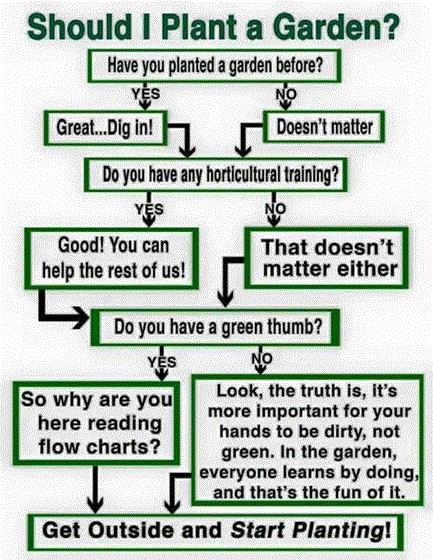
If I still had a horticulture business, I’d blow it up big and post it in a prominent spot.
Finally II ...
More industry humor, this time passed along from my friend Keith Cable, president of McHutchison and Vaughan’s Horticulture. Keith got it from another friend, McHutchison sales rep Ken Day (with whom I ate fried grubs in Mexico, but that’s another story). Here’s what Ken wrote:
We have all heard our customers tell us about how FedEx and UPS deliver or hand boxes to them with the arrows pointing in the wrong direction.
I was on the phone with a customer just now while he was receiving such a delivery.
My customer yelled to the delivery guy,“Turn the box around—the arrows are pointing in the wrong direction … there are live plants in those boxes.”
I could clearly hear the driver reply, “That’s only for when you open the box.”
Explains a lot!
Thanks Ken, and Keith, for the laugh. My suggestion? Print a smart-aleck comment on the bottom of your boxes to let drivers know they’ve got it wrong.
See you next time,

Chris Beytes
Editor
GrowerTalks and Green Profit
This e-mail received by 23,450 loyal readers!
Thanks to my loyal sponsors, who help me reach the 23,450 readers of Acres Online in 66 countries. Want to be one of them (a sponsor, that is)? Give Paul Black a shout and he'll hook you up.